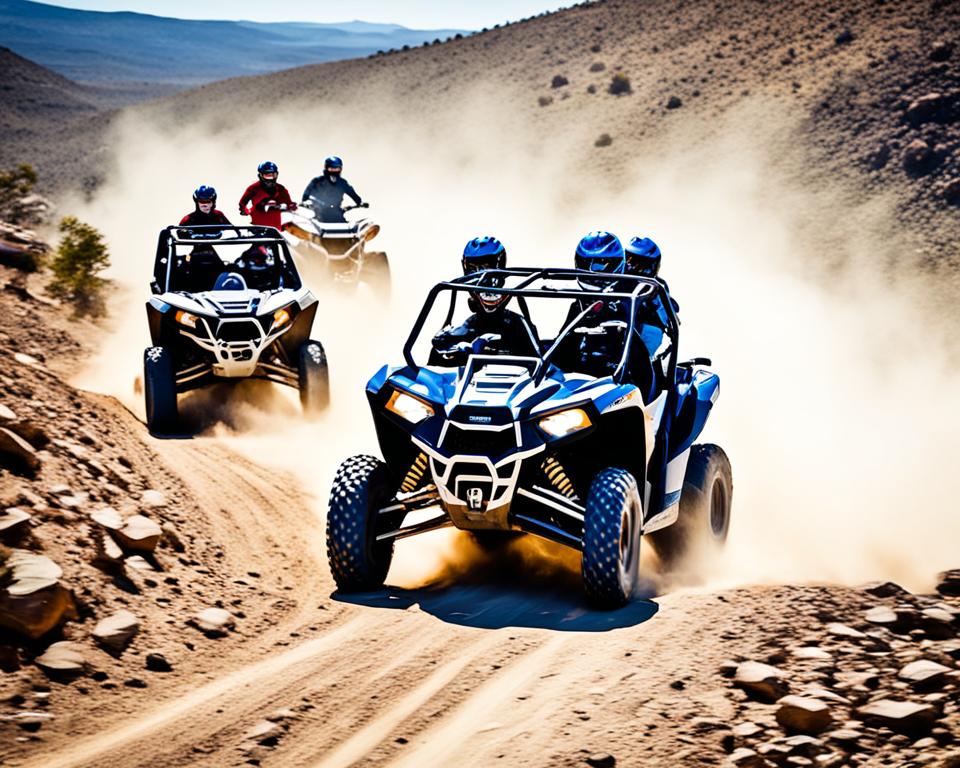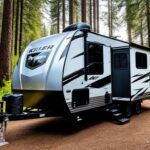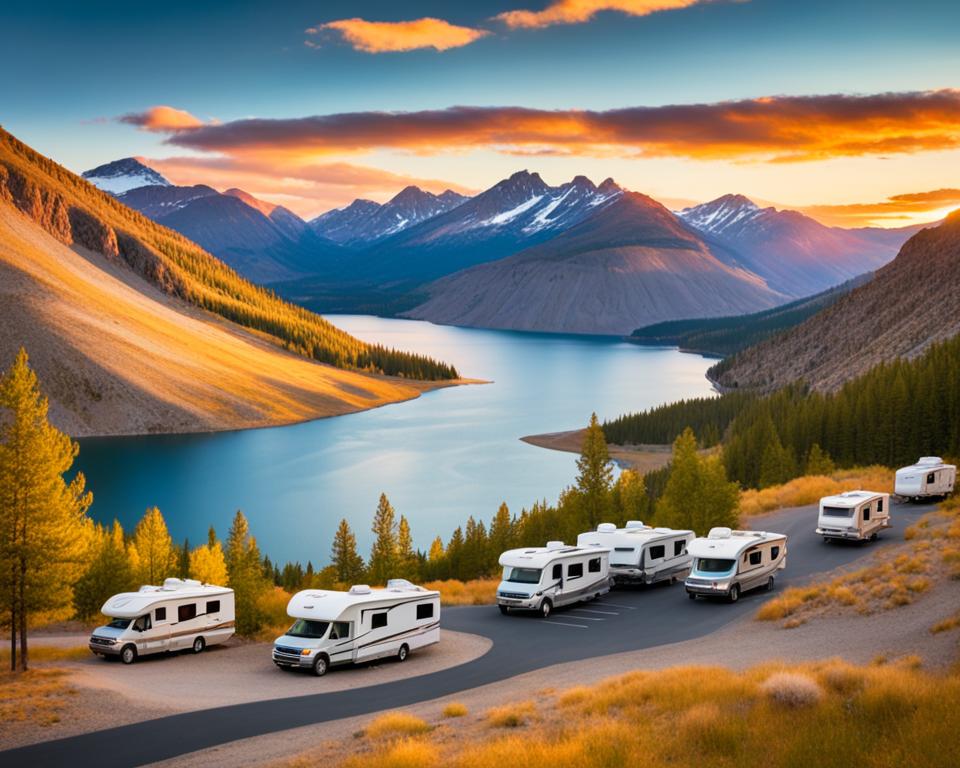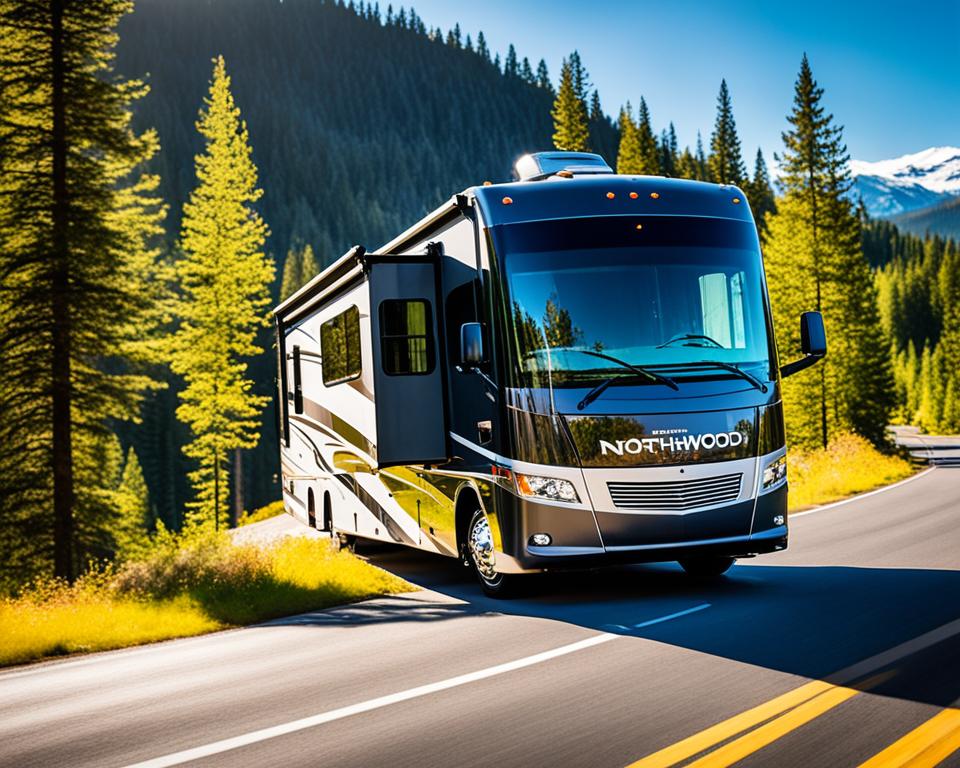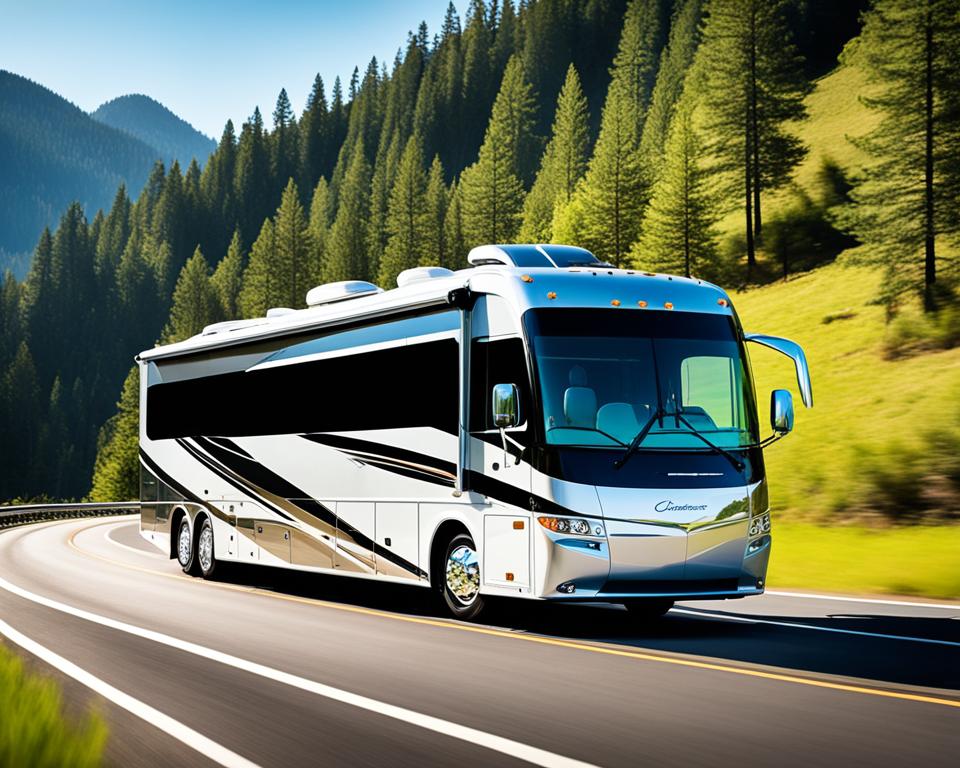ATVs, or all-terrain vehicles, are classified as recreational vehicles. They are designed with a straddle seating position, handlebar steering, and the ability to maneuver through various terrain conditions. ATVs can have either three or four wheels and are typically used for recreational purposes such as racing or trail riding. They offer a quick and nimble means of transportation over rough ground.
Key Takeaways:
- ATVs, or all-terrain vehicles, are classified as recreational vehicles.
- They are designed with a straddle seating position, handlebar steering, and the ability to maneuver through various terrain conditions.
- ATVs can have either three or four wheels and are typically used for recreational purposes such as racing or trail riding.
- They offer a quick and nimble means of transportation over rough ground.
- ATVs provide a thrilling and adventurous off-road experience.
Features of ATVs
ATVs, or all-terrain vehicles, possess unique characteristics that set them apart from other recreational vehicles. These features enable ATVs to tackle various terrains and provide an exhilarating off-road experience.
Key features of ATVs include:
- Straddle Seating Position: ATVs are designed with a straddle seating position, allowing riders to sit astride the vehicle for better balance and control.
- Handlebar Steering: Unlike traditional vehicles that use a steering wheel, ATVs are equipped with handlebars that enable precise maneuvering, making them agile and responsive.
- All-Terrain Capability: ATVs are specifically engineered to navigate through challenging terrains such as mud, rocks, sand, and steep slopes. With their rugged construction and specialized tires, they can effortlessly conquer off-road conditions.
While the basic features are consistent across all ATVs, there is also room for customization and modification to suit individual preferences. This allows riders to personalize their ATVs and enhance their off-road adventure.
ATVs are typically designed to accommodate one rider, ensuring optimal control and maneuverability. However, some models may offer the capacity to carry a passenger.
Controlling an ATV is made possible with a thumb throttle that controls acceleration. Additionally, ATVs can be equipped with either a brake handle or a foot pedal for braking, ensuring safety and control while riding these powerful machines.
With their versatility and capability to tackle various terrains, ATVs have become a popular choice for outdoor enthusiasts seeking thrilling off-road adventures.
| Feature | Description |
|---|---|
| Straddle Seating Position | Allows riders to sit astride the vehicle for better balance and control |
| Handlebar Steering | Enables precise maneuvering and responsive control |
| All-Terrain Capability | Designed to navigate through challenging terrains such as mud, rocks, sand, and steep slopes |
| Customization | Can be customized and modified to suit individual preferences |
| Passenger Capacity | Some models can carry a passenger |
| Thumb Throttle | Controls acceleration for precise control |
| Brake System | Equipped with a brake handle or foot pedal for safe stopping |
Safety Considerations for ATV Riding
While ATVs offer a fun and exhilarating off-road adventure, safety should always be a top priority. Operators should take precautions to ensure a safe and enjoyable experience.
Protective Gear
Operators should wear proper protective gear, including:
- Helmets: Protect the head from potential injuries.
- Clothing: Wear long sleeves and pants to protect the body from cuts and scratches.
- Boots: Choose sturdy boots that provide ankle support.
- Gloves: Protect hands and improve grip on the handlebars.
Medical Coverage
Considering that ATVs lack some of the safety features of other vehicles like UTVs, it is recommended to have medical coverage. Accidents can happen, and it’s essential to have the necessary coverage to handle any medical expenses that may arise.
Proper Sizing and Maintenance
ATVs come in various sizes and models. It’s crucial to choose an ATV that is suitable for the operator’s size and skill level. Proper sizing ensures better control and maneuverability of the vehicle. Additionally, regular maintenance of the ATV is necessary to keep it in safe operating condition.
Awareness of Twist Throttles
Operators should be aware of the potential dangers associated with twist throttles. These throttles can make it difficult to control the acceleration, especially in challenging terrain or sudden obstacles. Operators must exercise caution and practice proper throttle control.
By following these safety considerations, ATV riders can enjoy their outdoor adventures while minimizing the risks associated with off-road exploration.
Differences Between ATVs and UTVs
While both ATVs and UTVs are off-road vehicles, they differ in their intended purposes and functionality. ATVs, or all-terrain vehicles, are primarily designed for recreational use, providing riders with an exciting and adventurous experience. They are known for their agility and ability to traverse rough terrains, offering a thrilling off-road adventure.
On the other hand, UTVs, also known as utility terrain vehicles, are more focused on utility and practicality. These vehicles are commonly used in various industries, such as agriculture and construction, where the need for hauling equipment and supplies arises. UTVs offer larger storage space and have a standard wheelbase, providing more capacity for transporting goods.
One notable difference between ATVs and UTVs is the mode of control. ATVs typically feature handlebar steering, while UTVs are controlled by a steering wheel, similar to automobiles. This difference in steering mechanism allows for easier maneuverability and handling in different scenarios.
Seating capacity is another contrasting factor between the two vehicle types. ATVs are typically designed to accommodate a single rider, although there are models available with seating for two. On the contrary, UTVs generally offer seating for two to four passengers, allowing for group transportation during work-related tasks.
To summarize, ATVs excel in recreational activities, providing quick and nimble transportation over rough terrains for adventurous off-road experiences. UTVs, on the other hand, are practical work vehicles with their focus on hauling equipment and supplies, offering larger storage space and passenger capacity.
| Features | ATVs | UTVs |
|---|---|---|
| Intended Purpose | Recreational use | Utility and work purposes |
| Control Mechanism | Handlebar steering | Steering wheel |
| Seating Capacity | Single rider (some models seat two) | Two to four passengers |
| Storage Space | Limited | Larger storage capacity |
Safety and Insurance Considerations for UTVs
When it comes to safety and insurance, utility terrain vehicles (UTVs) offer several advantages over ATVs. UTVs are equipped with a range of safety features, including seatbelts, roll bars, and the option for a fully enclosed cabin. These features provide added protection for riders, especially during off-roading adventures in rugged terrains.
UTVs are often preferred for work purposes due to their larger size and storage capacity. Their ability to carry heavy loads and navigate challenging environments makes them ideal for various industries and outdoor recreation activities.
However, due to the specialized use and customization options available for UTVs, it is crucial to review and adjust insurance coverage accordingly. Comprehensive insurance that covers not only the vehicle but also any modifications is essential. This coverage should include protection against damage to the UTV, its accessories, and any liability arising from its use.
UTV Insurance Considerations:
- Review your existing insurance policy to determine if UTV coverage is included or if additional coverage is required.
- Consider specialized UTV insurance policies that offer comprehensive coverage tailored to off-roading adventures and outdoor recreation activities.
- Ensure that your insurance policy covers the UTV’s modifications, including aftermarket parts and accessories.
- Check for coverage against potential liability claims, such as property damage or bodily injury, that may arise from UTV operation.
- Compare insurance quotes from multiple providers to secure the best coverage at a competitive price.
It is important to note that UTV insurance premiums may be higher compared to ATVs due to their larger size and increased value, especially after customization. However, the peace of mind and financial protection that comprehensive insurance offers outweigh the cost.
| UTV Safety Features | UTV Insurance Considerations |
|---|---|
| Seatbelts | Review existing insurance policy |
| Roll bars | Specialized UTV insurance coverage |
| Fully enclosed cabin | Insurance coverage for modifications |
| Coverage against liability claims |
By ensuring adequate insurance coverage, UTV owners can enjoy their off-road adventures and outdoor recreation activities with greater peace of mind. So, before you hit the trails, make sure to review your insurance policy and talk to your insurance provider to ensure comprehensive protection for your UTV.
ATV Sizes and Age Recommendations
When it comes to ATVs, one size does not fit all. The ATV industry understands the importance of safety and recommends that riders choose an ATV that is appropriate for their age and size. This ensures a safe and enjoyable experience for adventure enthusiasts of all ages.
For younger riders, there are specialized youth models available. These ATVs are designed with smaller dimensions, including reduced handlebar height and narrower seat widths, to accommodate smaller hands and feet. Additionally, youth models typically have a limited top speed to ensure a controlled and safe riding experience.
Every ATV comes with a warning label that indicates the manufacturer’s recommended minimum age for operation. It is crucial for riders and parents to be aware of these recommendations and enforce them to promote safe ATV riding practices. The age recommendations are based on factors such as motor skills development and cognitive abilities, ensuring that riders are physically and mentally prepared to handle the challenges of operating an ATV.
By following the ATV industry’s age recommendations, riders can experience the thrill of outdoor recreation while prioritizing safety. Whether it’s exploring off-road trails or embarking on exciting adventures, age-appropriate ATVs provide a platform for unforgettable experiences.
Benefits of Choosing an Age-Appropriate ATV:
- Promotes safe riding practices
- Ensures optimal control and maneuverability
- Builds confidence in young riders
- Reduces the risk of accidents and injuries
Manufacturer Recommendations:
| Age Group | ATV Size | Speed Limit |
|---|---|---|
| 6-9 years old | Youth model with engine displacement up to 90cc | Up to 10 mph |
| 10-15 years old | Youth/Intermediate model with engine displacement up to 250cc | Up to 15 mph |
| 16+ years old | Adult model with engine displacement above 250cc | Depends on the ATV model |
It is crucial to adhere to the manufacturer’s age recommendations when selecting an ATV for young riders. This ensures that the ATV’s size, weight, and power are appropriate for the rider’s age and physical capabilities, reducing the risk of accidents and injuries.
Proper knowledge and understanding of ATV sizes and age recommendations contribute to a safe and exciting ATV experience. By choosing an age-appropriate ATV, riders can embark on thrilling adventures while prioritizing their well-being and enjoying the great outdoors.
ATVs in Agriculture and Other Industries
ATVs are not only popular for recreational purposes, but they also find practical applications in various industries. In agriculture, their speed and ability to navigate different terrain conditions make them invaluable. Farmers and workers rely on ATVs to streamline daily tasks and improve efficiency. They are commonly used for hauling feed, hay, and supplies on farms, providing a reliable means of transportation that can easily maneuver through challenging terrains.
Additionally, ATVs have found their way into non-agricultural settings, such as schools and sports facilities. They are often utilized to transport water jugs, sports equipment, and even athletes from one location to another. The versatility and customizability of ATVs make them an ideal choice for a wide range of industries, offering efficient and reliable solutions for transporting equipment and materials.
| Industry | Applications |
|---|---|
| Agriculture | Hauling feed, hay, and supplies |
| Landscaping | Transporting tools and equipment |
| Construction | Moving materials and tools on job sites |
| Recreation | Off-road adventures and tours |
| Event Management | Facilitating logistics and transportation |
Whether it’s in farming, landscaping, construction, or event management, ATVs prove their worth as reliable adventure vehicles for both work and play. Their off-road capabilities and adaptability make them an asset in virtually any industry that requires efficient transportation and operation in challenging terrains.
The History of ATVs
The history of ATVs, also known as all-terrain vehicles, traces back to the late 19th century when the first powered four-wheelers were introduced. However, it wasn’t until the 1960s and 1970s that the modern concept of straddle-ridden ATVs, similar to the ones we know today, began to take shape.
In the 1970s and 1980s, three-wheeled ATVs gained popularity, with Honda leading the way in their production. These three-wheelers were versatile and offered thrilling off-roading experiences to adventure enthusiasts. However, due to safety concerns and accidents associated with improper handling, production of three-wheeled ATVs ceased in 1987.
Following the discontinuation of three-wheelers, manufacturers shifted their focus to four-wheeled ATVs. With increased stability and safety features, four-wheelers became the preferred choice for recreational off-roading. To ensure the proper use of ATVs, safety standards were introduced, emphasizing the importance of responsible riding practices and protective gear.
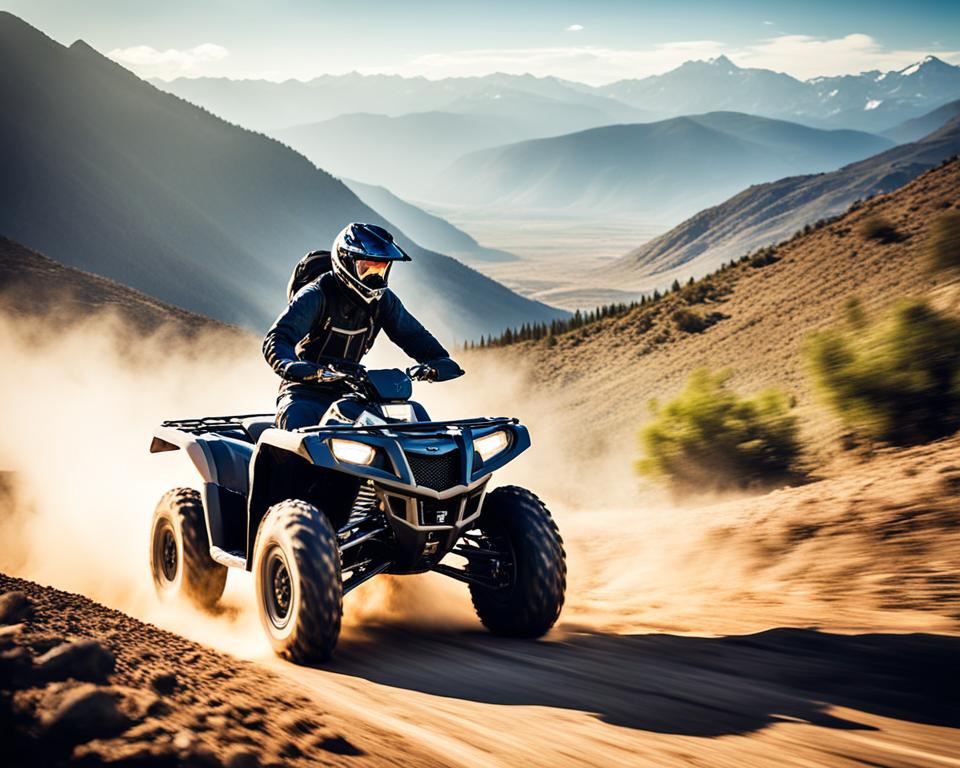
ATVs have a rich history that spans over a century, offering thrilling outdoor adventures.
Conclusion
ATVs are indeed recreational vehicles, offering a thrilling and adventurous off-road experience. These versatile vehicles are designed for maneuverability, allowing riders to navigate rough terrain with ease. Whether you’re racing through forest trails or exploring remote landscapes, ATVs provide a unique sense of freedom and excitement.
However, it is crucial to prioritize safety when operating an ATV. Wearing proper protective gear, such as helmets, clothing, boots, and gloves, is essential to minimize the risk of injury. Regular maintenance of your ATV is also important to ensure optimal performance and reliability.
Understanding the differences between ATVs and UTVs can help riders choose the vehicle that best suits their needs. While ATVs excel in recreational activities, UTVs are more focused on work applications, with larger storage capacity and additional safety features.
Whether you’re an outdoor enthusiast seeking thrilling adventures or a rugged individual requiring a reliable off-road vehicle for work purposes, ATVs are the perfect choice. Experience the joy of outdoor recreation and embark on thrilling adventures with these incredible adventure vehicles.
FAQ
Are ATVs considered recreational vehicles?
Yes, ATVs, or all-terrain vehicles, are classified as recreational vehicles.
What are the features of ATVs?
ATVs have a straddle seating position, handlebar steering, and the ability to maneuver through various terrain conditions.
What are some safety considerations for ATV riding?
When riding an ATV, it is important to wear protective gear, have medical coverage, properly size and maintain the ATV, and be aware of potential dangers.
How do ATVs differ from UTVs?
While both are off-road vehicles, ATVs are primarily for recreation and offer quick transportation, whereas UTVs have larger storage space and are often used for work purposes.
What safety and insurance considerations are there for UTVs?
UTVs generally have more safety features than ATVs and may require adjusted insurance coverage to account for modifications. Comprehensive insurance coverage is essential.
Are there different ATV sizes and age recommendations?
Yes, ATV riders should operate an ATV appropriate for their age and size. Youth models are available for younger riders.
How are ATVs used in agriculture and other industries?
ATVs are popular in agriculture for their speed and ability to navigate various terrains. They are also used in other industries for transporting equipment.
What is the history of ATVs?
The history of ATVs dates back to the late 19th century, with the development of straddle-ridden vehicles. Three-wheeled ATVs gained popularity in the 1970s, but safety concerns led to the focus on four-wheeled ATVs.
Can ATVs be customized and modified?
Yes, ATVs can be customized and modified to fit individual preferences.

